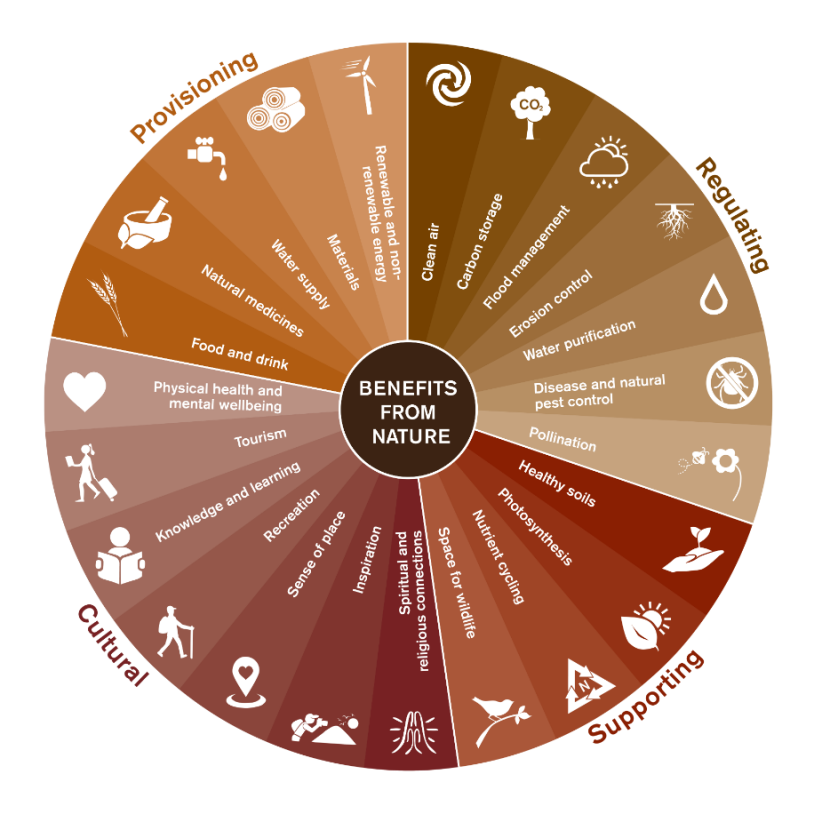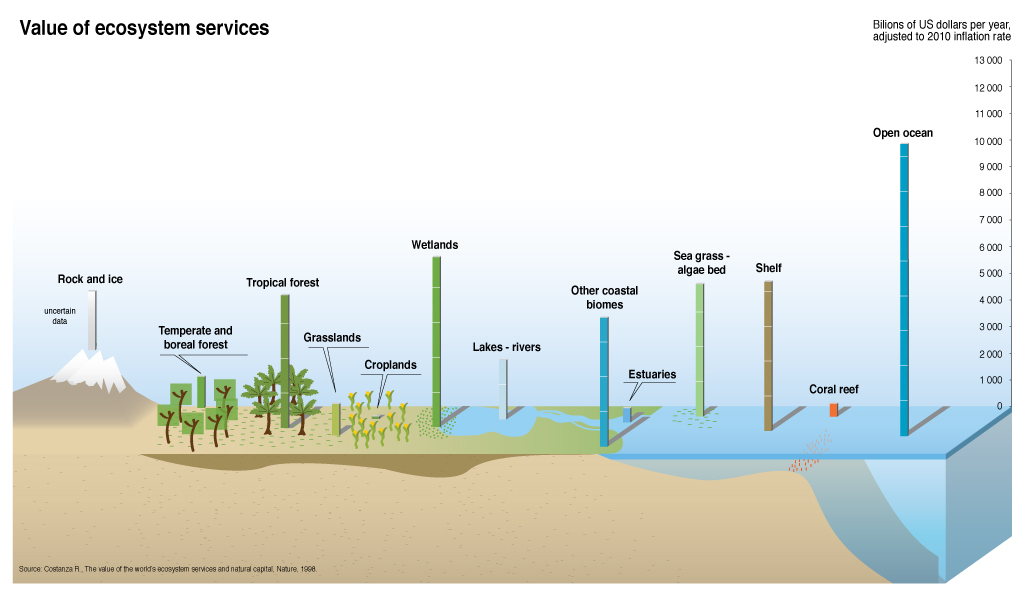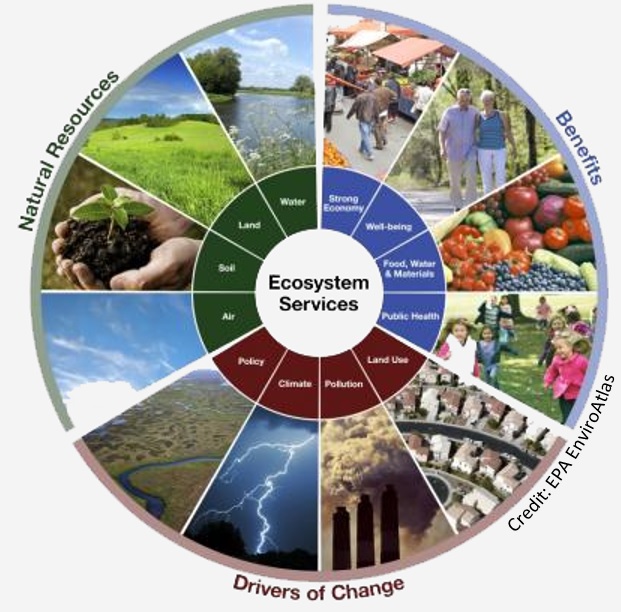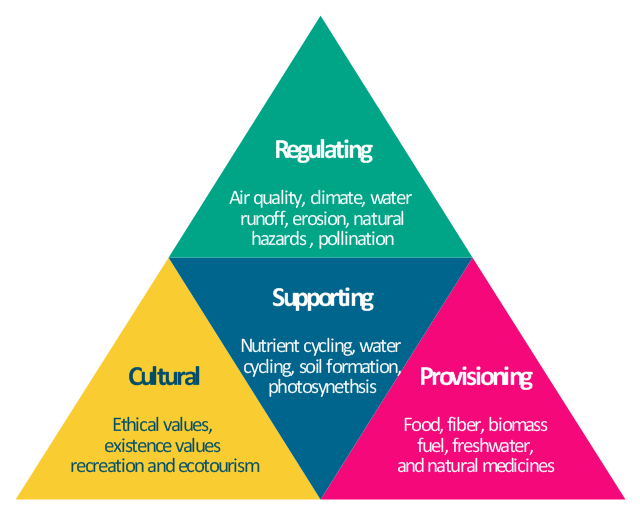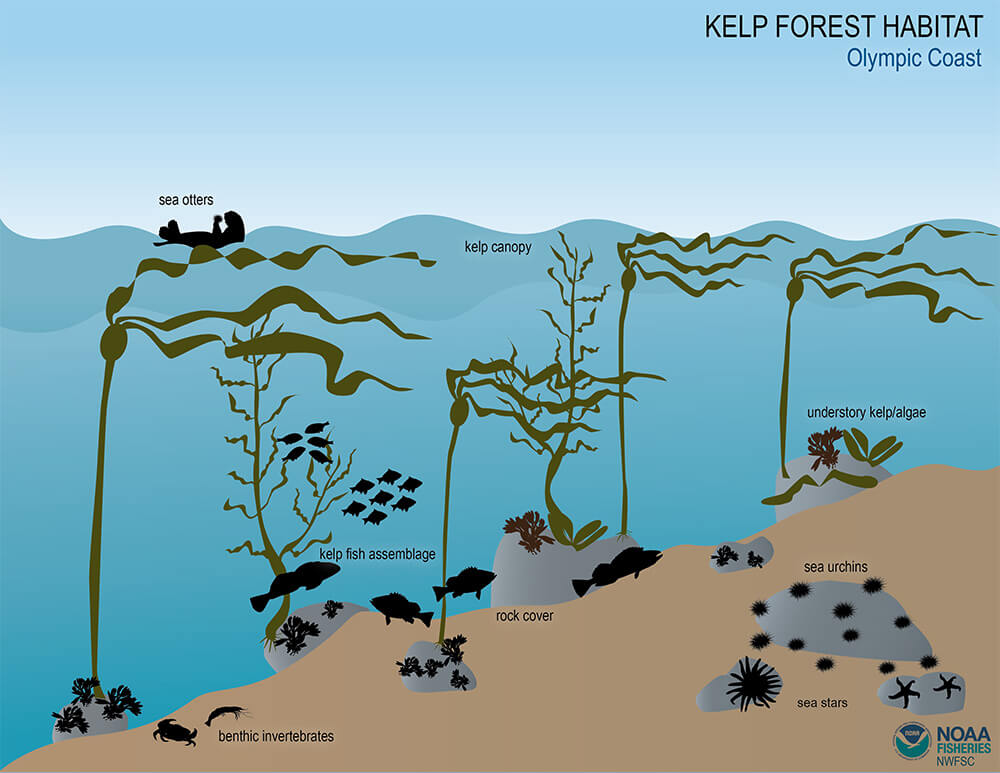Topic ecosystem services list: Discover the pivotal roles of nature through our "Ecosystem Services List," highlighting how these services sustain and enrich our lives while offering solutions for environmental sustainability.
Table of Content
- What is a detailed list of ecosystem services that are commonly identified in research and literature?
- Understanding Ecosystem Services
- Four Types of Ecosystem Services: Provisioning, Regulating, Cultural, and Supporting
- Provisioning Services: Food, Water, Timber, and More
- Regulating Services: Climate Regulation, Flood Control, and Pollination
- Cultural Services: Recreation, Aesthetic Value, and Spiritual Enrichment
- Supporting Services: Nutrient Cycling, Soil Formation, and Photosynthesis
- YOUTUBE: Ecosystem Services Explained
- The Role of Biodiversity in Ecosystem Services
- Ecosystem Services in Action: Case Studies and Real-World Examples
- Challenges and Threats to Ecosystem Services
- Conservation Efforts and the Future of Ecosystem Services
- Tools and Resources for Understanding and Preserving Ecosystem Services
What is a detailed list of ecosystem services that are commonly identified in research and literature?
Here is a detailed list of ecosystem services that are commonly identified in research and literature:
- Provisioning Services:
- Food production
- Water supply
- Timber and fiber
- Genetic resources
- Medicinal resources
- Regulating Services:
- Climate regulation
- Water purification
- Pest and disease control
- Flood regulation
- Waste decomposition and detoxification
- Supporting Services:
- Soil formation
- Nutrient cycling
- Primary production
- Cultural Services:
- Recreational opportunities
- Aesthetic value
- Spiritual and religious significance
- Educational opportunities
READ MORE:
Understanding Ecosystem Services
Ecosystem services are the vast array of benefits that humans freely gain from the natural environment and from properly-functioning ecosystems. Such services include, but are not limited to, products like clean drinking water and processes that reduce flooding and droughts. Understanding these services helps us appreciate the intrinsic value of biodiversity and ecosystems to human life and well-being.
- Provisioning Services: These are the products obtained from ecosystems, including food, fresh water, wood, fiber, and genetic resources.
- Regulating Services: These include the regulation of climate, floods, disease, wastes, and water quality as well as pollination and pest control.
- Cultural Services: Non-material benefits obtained from ecosystems through spiritual enrichment, cognitive development, reflection, recreation, and aesthetic experiences.
- Supporting Services: These services are necessary for the production of all other ecosystem services, such as soil formation, photosynthesis, and nutrient cycling.
Each category plays a crucial role in the overall health of our planet, influencing everything from our food supply to the air we breathe and the water we drink. By understanding and preserving these services, we can ensure a healthier planet and a sustainable future for all.

Four Types of Ecosystem Services: Provisioning, Regulating, Cultural, and Supporting
Ecosystem services are critical to human survival and well-being, providing essential goods and services from nature. These can be categorized into four main types:
- Provisioning Services: These are the products people obtain from ecosystems, including food, water, timber, fiber, and genetic resources. They are the most direct benefits we receive from ecosystems.
- Regulating Services: These include benefits obtained from the regulation of ecosystem processes, such as air quality regulation, climate regulation, water purification, erosion control, and disease regulation, among others. They play a crucial role in making our environments livable.
- Cultural Services: These are the non-material benefits people obtain from ecosystems through spiritual enrichment, cognitive development, recreation and leisure, and aesthetic experiences. Cultural services significantly contribute to the cultural, spiritual, and recreational aspects of human societies.
- Supporting Services: These services are necessary for the production of all other ecosystem services. They include soil formation, photosynthesis, primary production, nutrient cycling, and water cycling. These processes underpin the functioning of the planet"s ecosystems.
Understanding these services helps us to appreciate the myriad ways in which natural ecosystems contribute to making the Earth habitable and maintaining the quality of human life. It underscores the importance of biodiversity and ecosystem health in providing sustainable benefits to humanity.
Provisioning Services: Food, Water, Timber, and More
Provisioning services are fundamental ecosystem services that provide the materials we rely on daily. These services include a wide range of tangible goods produced by natural ecosystems, essential for human survival and economic activities.
- Food: Ecosystems provide the basis for food production, including crops, livestock, fisheries, and wild foods. These resources are vital for nutrition and the sustenance of human populations worldwide.
- Water: Freshwater systems play a crucial role in supplying water for drinking, irrigation, sanitation, and industrial processes. The availability of clean water is a cornerstone of public health and economic development.
- Timber and Fiber: Forests and other ecosystems supply timber for construction, furniture, and other uses. Additionally, they provide fibers for clothing, paper products, and other materials.
- Natural Medicines and Pharmaceuticals: Many ecosystems, particularly tropical forests, are rich sources of natural medicines and compounds used in pharmaceuticals, highlighting the importance of biodiversity for health and well-being.
- Fuel: Wood, biofuels, and other biomass sourced from ecosystems are important energy sources for many communities around the world, especially in rural areas.
Provisioning services are directly linked to human welfare and economic activities. Their sustainable management is essential to ensure that we do not deplete these precious resources, maintaining their availability for future generations.
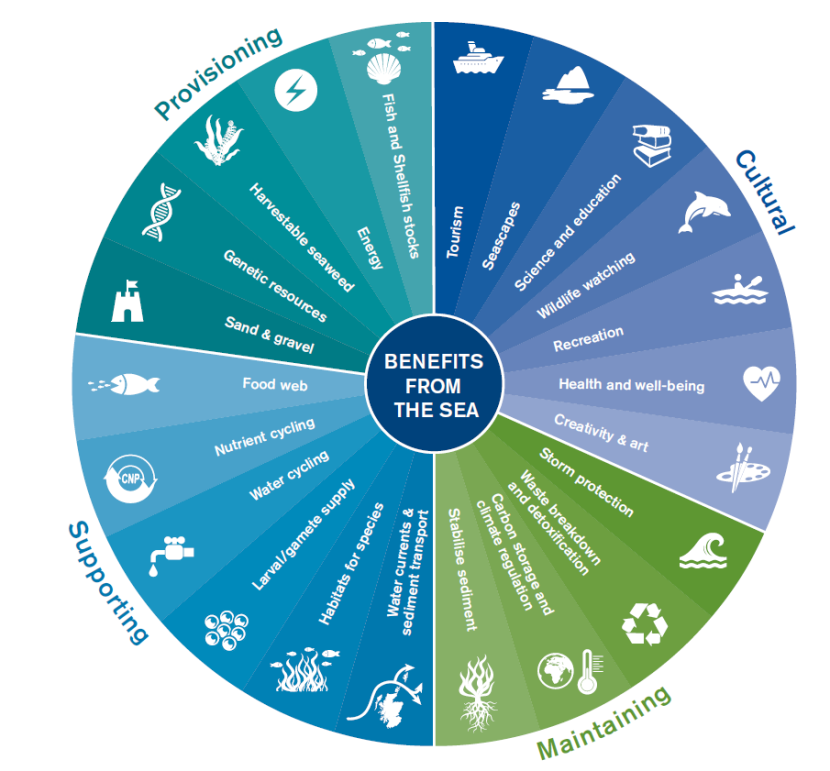
Regulating Services: Climate Regulation, Flood Control, and Pollination
Regulating services are critical ecosystem functions that maintain the balance of the natural environment. These services are often unseen but are vital for stabilizing the Earth"s climate, managing water flows, and supporting agriculture and biodiversity.
- Climate Regulation: Ecosystems such as forests, oceans, and wetlands play key roles in regulating the Earth"s climate by capturing carbon dioxide, a major greenhouse gas. This service is crucial for mitigating the impacts of climate change.
- Flood Control: Wetlands, rivers, and lakes naturally regulate water flow, reducing the risk and severity of floods. By absorbing excess rainwater and releasing it slowly, these ecosystems protect communities from the devastating effects of natural disasters.
- Pollination: Bees, butterflies, birds, and other animals pollinate plants, enabling the production of fruits, vegetables, and seeds. This service is essential for food production and the sustainability of agricultural ecosystems.
- Water Purification: Natural ecosystems filter pollutants and sediment from water, improving its quality for drinking, agriculture, and recreation. Forests, wetlands, and riparian zones are particularly effective at purifying water.
- Disease Regulation: Healthy ecosystems can help control diseases by regulating the populations of disease vectors such as mosquitoes. Biodiverse ecosystems are also less likely to harbor large populations of disease hosts.
Regulating services are indispensable to human survival and economic prosperity. They underscore the importance of conserving and restoring ecosystems to ensure these services continue to benefit society as a whole.
Cultural Services: Recreation, Aesthetic Value, and Spiritual Enrichment
Cultural services provided by ecosystems contribute significantly to the human experience, enriching our lives in many intangible ways. These services foster a deep connection with nature that sustains our spiritual, psychological, and recreational activities.
- Recreational Activities: Natural landscapes and ecosystems offer unique settings for recreation and leisure activities such as hiking, birdwatching, fishing, and camping. These activities not only provide enjoyment and relaxation but also promote physical health and well-being.
- Aesthetic Appreciation: The beauty of natural environments inspires artists, photographers, and writers, enriching cultural expression and providing aesthetic pleasure to society. Scenic landscapes and wildlife are valued for their intrinsic beauty and are a source of creative inspiration.
- Spiritual Enrichment: Many cultures and religions attribute spiritual significance to natural sites and elements, finding peace, solace, and a sense of connection in the natural world. Sacred groves, rivers, and mountains are central to many spiritual practices and traditions.
- Educational Value: Ecosystems serve as living classrooms, offering endless opportunities for learning and discovery about nature and biodiversity. Environmental education programs and ecotourism initiatives help raise awareness about the importance of conservation.
- Cultural Heritage and Identity: Natural landscapes are deeply intertwined with the cultural heritage and identity of communities. Traditional knowledge and practices related to the environment are passed down through generations, maintaining a living link with the past.
Preserving ecosystems and their cultural services is crucial for maintaining the richness of human culture and ensuring that future generations can continue to experience and appreciate these invaluable benefits.

Supporting Services: Nutrient Cycling, Soil Formation, and Photosynthesis
Supporting services are fundamental ecological processes that underpin the production of all other ecosystem services. They create the essential conditions for life on Earth, making them indispensable for the health of the planet and the well-being of its inhabitants.
- Nutrient Cycling: Ecosystems recycle nutrients, converting them into forms that can be used by plants and animals. This service is crucial for the productivity of terrestrial and aquatic environments, supporting food webs and maintaining ecosystem health.
- Soil Formation: The formation of soil is a slow but vital process that supports plant life, which in turn supports diverse terrestrial ecosystems. Soil is a complex mixture of organic matter, minerals, gases, liquids, and countless organisms that together support life on land.
- Photosynthesis: Photosynthesis is the process by which plants, algae, and some bacteria convert sunlight into energy, producing oxygen as a byproduct. This fundamental biological process is the basis for most life on Earth, supplying the oxygen we breathe and serving as the primary source of energy for food chains.
- Water Cycling: The movement of water through ecosystems in its various states—vapor, liquid, and ice—is another supporting service. Water cycling regulates climate, transports nutrients and waste, and is critical for all life forms.
These supporting services are so foundational that without them, ecosystems would cease to function, leading to the collapse of the services they underpin. Protecting and restoring these processes is essential for sustaining biodiversity, ecosystem resilience, and human livelihoods.
Ecosystem Services Explained
Ecosystem services are the invaluable benefits that nature provides us, from clean air and water to pollination and climate regulation. Discover the wonders of these essential services in action by watching our enlightening video showcasing their significance. Biodiversity is the key to a thriving and resilient ecosystem, showcasing the beauty and complexity of life on Earth. Immerse yourself in the stunning diversity of plant and animal species by watching our captivating video that highlights the importance of protecting and preserving biodiversity.
Ecosystem Services and Biodiversity in Environmental Science
To keep Europe\'s ecosystems healthy, we need to protect #biodiversity. How can the ecosystem service approach help? And how ...
The Role of Biodiversity in Ecosystem Services
Biodiversity, the variety of life in all its forms, plays a pivotal role in maintaining and enhancing ecosystem services. These services are the natural benefits humans derive from ecosystems, categorized into provisioning, regulating, cultural, and supporting services. Biodiversity contributes to the resilience and stability of ecosystems, enabling them to respond to environmental changes and disturbances, and thus maintain their functionality.
- Regulating Services: Diverse ecosystems regulate climate, water quality, and disease prevalence. For example, forests sequester carbon, reducing greenhouse gases, and wetlands purify water by filtering pollutants.
- Provisioning Services: A wide range of species contributes to the provision of food, fresh water, medicinal resources, and raw materials. Genetic diversity within crops and livestock can lead to more resilient agricultural systems.
- Cultural Services: Biodiversity enriches cultures and supports recreational, aesthetic, and spiritual values. Diverse landscapes and wildlife inspire art, folklore, and religious practices, and offer spaces for recreation and tourism.
- Supporting Services: Fundamental ecological processes such as soil formation, nutrient cycling, and primary production are underpinned by biodiversity. These processes are crucial for the production of oxygen, decomposition of organic material, and pollination of plants, including many crops.
However, human activities are leading to unprecedented rates of biodiversity loss, threatening the continuity of these ecosystem services. Conservation and sustainable management of biodiversity are therefore essential for preserving ecosystem resilience and ensuring the continued provision of vital services.
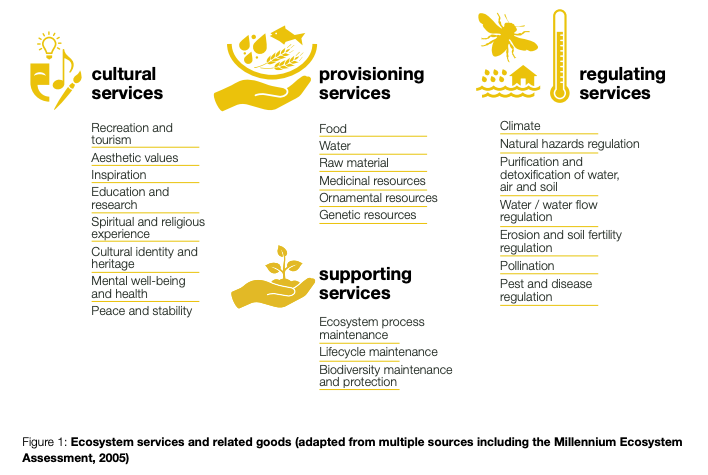
Ecosystem Services in Action: Case Studies and Real-World Examples
Ecosystem services provide essential benefits to human societies, derived directly and indirectly from natural environments and processes. Real-world examples highlight the tangible impact of these services across various ecosystems.
- Water Purification: Natural ecosystems play a critical role in purifying water, reducing the need for artificial filtration systems. For instance, the Catskill Watershed in New York, once restored, was able to meet drinking water standards, saving billions in potential costs for a water filtration plant.
- Pollination Services: Pollination by wild bees is vital for food production, contributing to 15-30% of U.S. food production. In California"s agricultural region, the presence of wild bees and natural habitats within close proximity to farms has been shown to enhance pollination services, acting as a form of natural insurance for farmers.
- Flood Protection: Coastal and estuarine ecosystems, including wetlands and mangrove forests, serve as buffer zones that absorb impacts from natural hazards such as floods and storms, protecting inland areas and reducing damage.
- Forest Products: Forests are a source of diverse products beyond timber, including non-wood forest products like fodder, medicinal plants, and wild foods. These resources are crucial for the livelihoods of billions worldwide, offering nutritional and economic benefits.
These examples underscore the importance of conserving natural ecosystems to sustain the ecosystem services upon which human well-being relies. Efforts to protect and restore ecosystems not only preserve biodiversity but also enhance the resilience and functionality of these natural systems, providing long-term benefits to human societies.
Challenges and Threats to Ecosystem Services
Ecosystem services face numerous challenges and threats that can significantly impact their ability to support human welfare and biodiversity. Understanding these threats is crucial for developing effective conservation strategies.
- Climate Change: Climate change is a significant threat to ecosystem services, affecting weather patterns, sea levels, and biodiversity. These changes can lead to the loss of habitats and the services they provide, such as carbon sequestration and flood regulation.
- Deforestation: The clearing of forests for agriculture, logging, and urban development leads to the loss of provisioning services like timber and non-wood forest products, as well as regulating services like carbon storage and water purification.
- Pollution: Water and air pollution from industrial, agricultural, and urban sources can degrade ecosystems, reducing their ability to provide clean water, air purification, and other essential services.
- Overexploitation: The unsustainable extraction of natural resources, including overfishing and overharvesting of timber and wild plants, threatens the sustainability of provisioning services and the ecosystems that support them.
- Habitat Loss and Fragmentation: The conversion of natural habitats into agricultural or urban areas not only reduces biodiversity but also disrupts the ecological processes that underpin ecosystem services.
- Invasive Species: Non-native species can outcompete native species, disrupt ecosystems, and diminish the provision of ecosystem services such as pollination and disease regulation.
Addressing these challenges requires integrated conservation efforts that consider the complex interdependencies within ecosystems and the socio-economic factors that drive environmental change.

Conservation Efforts and the Future of Ecosystem Services
The future of ecosystem services hinges on concerted conservation efforts to mitigate the impacts of various threats and ensure the sustainability of these vital resources. Effective conservation strategies are multifaceted, involving a combination of scientific, socio-economic, and policy-driven approaches.
- Protected Areas: Establishing and expanding protected areas, such as national parks, wildlife reserves, and marine sanctuaries, to safeguard critical habitats and biodiversity.
- Restoration Projects: Initiatives aimed at restoring degraded ecosystems, such as reforestation, wetland restoration, and coral reef rehabilitation, to revive ecosystem functions and services.
- Sustainable Practices: Promoting sustainable agricultural, forestry, and fishing practices to reduce environmental impacts while maintaining economic viability.
- Policy and Legislation: Implementing effective environmental policies and regulations that support ecosystem conservation and sustainable resource management.
- Community Engagement: Involving local communities in conservation efforts, recognizing their role as stewards of the environment and leveraging traditional knowledge.
- Scientific Research: Supporting research to better understand ecosystems and their services, which can inform more effective conservation and management strategies.
The future of ecosystem services also relies on addressing global challenges such as climate change, which requires international cooperation and action to reduce greenhouse gas emissions and adapt to changing environmental conditions. By combining local actions with global initiatives, it is possible to preserve ecosystem services for future generations, ensuring a balance between human well-being and the health of our planet.
READ MORE:
Tools and Resources for Understanding and Preserving Ecosystem Services
Various tools and resources have been developed to help understand and preserve ecosystem services, facilitating informed decision-making and effective conservation strategies. These resources are invaluable for researchers, policymakers, educators, and the general public to grasp the intricacies of ecosystems and their services.
- Millennium Ecosystem Assessment (MA): A comprehensive framework for analyzing the consequences of ecosystem change for human well-being, identifying the condition and trends of the world"s ecosystems and their services.
- The Economics of Ecosystems and Biodiversity (TEEB): An initiative focused on making nature"s values visible, emphasizing the economic benefits of biodiversity and highlighting the growing costs of biodiversity loss and ecosystem degradation.
- GIS and Remote Sensing: Geographical Information Systems (GIS) and remote sensing technologies provide detailed spatial analyses, enabling the mapping and monitoring of ecosystems and their services over time.
- EnviroAtlas: An interactive tool by the EPA that provides geospatial data, tools, and resources to help decision-makers understand the benefits and tradeoffs of various environmental decisions.
- Ecosystem Service Valuation Tools: Various software and methodologies, such as InVEST (Integrated Valuation of Ecosystem Services and Tradeoffs), allow users to assess the value of ecosystem services under different management and policy scenarios.
- Educational Resources: Organizations like the National Wildlife Federation offer educational programs and resources to teach younger generations about the importance of ecosystems and biodiversity.
These tools and resources, among others, are fundamental in promoting a deeper understanding of ecosystem services and fostering a more sustainable interaction with our natural environment.
Discover the pivotal role of ecosystem services in sustaining life and well-being. Unravel the intricate web of nature"s offerings through our comprehensive guide, inspiring a deeper connection and commitment to Earth"s invaluable systems.
